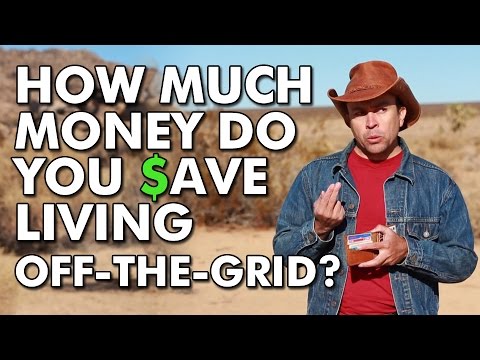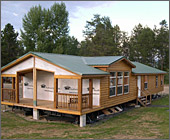
Upcycling: Keep the old & turn it into something new
https://www.off-grid
Auto Amazon Links: No products found.

https://www.off-grid
Auto Amazon Links: No products found.


This post is a very dirty assessment of how off-grid living has saved me money and can help you do the same.
All my estimates will be for an average 4 person home in the United States. While the results will vary based on country, and locality, the overall premise will remain the same.
Alright, so my disclaimer: I’m not a scientist. I don’t pretend to be and I would rather never be one. I am an average, albeit hyper-logical, American so for my purposes, all of my numbers are very crude. I literally Google searched averages and I used the data from the most reputable looking website that came up. That said, we aren’t working on nuclear fusion, so I think crude logic is enough for our purposes here. Take all the averages with a grain of salt.
Also, I am using my home for the final calculations and comparisons. It is a 1400 sq ft earthbag construction open floorplan home, 50% bermed into a hill, with south-facing windows, and an energy efficient design. Your home may be bigger or smaller, so again, your numbers will vary.
Land
I will start at the beginning. Land. For our purposes, I will assume both properties will be on the same land. While in real life, someone living off-grid has very different land needs than someone linked-in, land varies in price so much from place to place that we will leave it as a constant in this example.
So both our example houses are built on a $20,000 20-acre plot of land. Difference= $0
Construction of linked-in home: (US avg) $200 per sqft x1400sqft = $280,000
Construction of Off-Grid home: (mine) $36 per sqft x1400sqft = $50,000
Savings: Off-Grid $230,000
Mind you the construction process was much slower and I had to do almost all my work by hand, the savings from construction of a home made of dirt compared to one made of conventional wooden frame and insulation are obvious.
Next are the infrequent expenses. Listed below are the appliances and expenses that one will have different than the other.
| Linked-In | Off-Grid | ||
| Toilet ea. (conventional) | $200 | Toilet (homemade compost) | $15 |
| Oil Tank | $700 | Solar Electric System | $10,000 |
| Water Heater (elec) | $600 | Solar Water Heater | $9,000 |
| Space Heating | $4,000 | Radiant Flooring | $5,000 |
| Air Conditioner | $750 | Cisterns (13,000Gal) | $6,400 |
| Total | $2,650 | Total | $30,415 |
Difference: $27,765 in favor of conventional homes. Ouch. The Linked-In setup has a much cheaper initial set-up price but if we look at the difference in cost of construction from above, I think we have this extra expense covered. Let’s see how we do when we look at our long term living expenses.
| Linked-In (per year) | Off-Grid (per year) | ||
| Water (non-toilet) | $360 | $0 | |
| Water (toilet) | $109 | $0 | |
| Space Heating |

We chose to downsize our lives, though in many ways we are living better than we did before. By turning our backs on consumerism, choosing to live more simply, being more frugal, we are able to live on so much less. This has done a couple of things for us, by giving up most things that create monthly bills, we don’t have to worry about falling behind and losing things or going into bankruptcy. We don’t do anything that generates bills, ie no credit cards, no loans, no car payments and such. Of course we have bills, I’d say that everyone does, but we have actively worked to pare them down to the bare minimum.
Auto Amazon Links: No products found.

It’s NOT too late to start prepping! If you are still breathing, and you are reading this, it’s not too late to start prepping! Even though the main stream media is doing its utmost best to make preppers look like the bad guy, that’s not your problem, your focus needs to be on taking care of yourself and your family, the more people you are responsible for, the more you need to buckle down and get ready for whatever may be coming down the pike.
The USA is still considered a prosperous country with lots of safety nets, I’m here to tell you that we are on a very slippery slope, what is at the bottom of that slope? Well, look around at what’s going on in other countries that were once prosperous and see where they are now. With the dollar being devalued quicker and quicker, hint that means the buying power of a dollar is less and less, saving money, ie savings accounts, hiding it under your mattress and such shouldn’t be your top priority right now, unless you already have a major stock of food and other necessities put back.
Auto Amazon Links: No products found.
Saving money, everyone talks about it, everyone wants to do it, but it’s hard to do. With most of us on tight budgets, it’s more important than ever to save every penny you can.
The main reason saving money seems hard to do is it usually means having to give up something that you would normally want to buy or do. My hubby and I live off-grid, we budget ourselves tightly, that includes food, but we still eat very well, the trick is to find ways of saving that doesn’t hurt so much. Here are some of the ways I save money. Let’s focus on food, something we all have to have to survive.
Auto Amazon Links: No products found.
With prices on everything going up and our earnings going down, many of us are living on the edge, some of us are only one paycheck away from being homeless. Right now, food and supplies for everyday living is readily available, you can walk into any store and find the shelves stocked with food. But you must realize those shelves can be empty in just a matter of hours in any kind of major emergency. These types of emergencies can be on a global scale, solar flares, asteroid or comets impacting the earth, to regional problems such as hurricanes, floods, wildfires, to very local problems, such as a car hitting a power pole knocking out the power for your entire neighborhood… even down to a very personal crisis, like losing your job, being injured and not being able to work, having an unexpected bill. What can you do to help ensure that you will survive?
As I mentioned, grocery stores have stocks of food, right now, but that could change in a heartbeat. It used to be that grocery stores had larger warehouse areas in the back of the store, they received fewer but larger shipments. Now, most stores have at best, a 3 day supply of food in the store, including the stock room in back. They receive multiple shipments a week, but ultimately receive less stocks of food from each one. If anything were to happen to the transportation of these foods, trucks, or trains, or airplanes or ships, then your grocery store will run out of food within about 3 days, that’s IF there isn’t a panic run on food, then you have hours at best. If something happened and you could not leave your home, starting right now, today, how long would it be before you started running out of food? How long before you would be in real trouble? A few days? A week? A couple of weeks? A month?
Today I’ll talk about how to prep in the area of food, even if you are on the tightest of budgets. If you say to me that you cannot afford to put back extra food for emergencies, I will tell you that is precisely WHY you need to do it. If you have extra food, even as little as an extra 2 weeks to a month’s worth of food, then in a financial emergency, such as an unexpected bill, or job loss, you will not have to choose between buying groceries and paying your rent or mortgage.
First you need to decide how much extra you can spend, if you do not have a budget written down, it’s time to do it and see just where your money goes, you might be surprised as to how much waste happens a few dollars here and a few dollars there. I know there are ways you can …


Lately, I keep reading about how more mainstream people are jumping in, purchasing solar panels, adding passive solar rooms, collecting rain water. I read about people who build $300,000+ green homes, that price doesn’t include the price of the land it sits upon! It’s all fine and dandy for those who have lots of readily available cash sitting around, or worse, they get loans to bankroll their ubergreen homes.
Auto Amazon Links: No products found.

Super Good Cents log home, Idaho . Pioneers living in log cabins were part of American frontier times. Now its part of the new frontier — living a healthy and self-sustaining lifestyle.
The choices available to those wishing to build a log home range from factory pre-cut to handmade on-site. Pre-cut kits are nothing new and have been available since 1923. Most manufactures will allow homeowners to customize their design to make it almost as one-of-a-kind as those handmade on-site.
A plus of log homes is that since most log homes are produced from local renewable wood sources they use much less energy
Auto Amazon Links: No products found.
2023 © Off-Grid.net
9b Audrey St. London E2 8QH
email news@off-grid.net
call US office: toll-free 1-877-706-7423
OR
UK: +44 207 729 2749
How to register – Coming Soon
How to Manage your off-grid account
How to use the off-grid map – Coming Soon
Coming Soon
